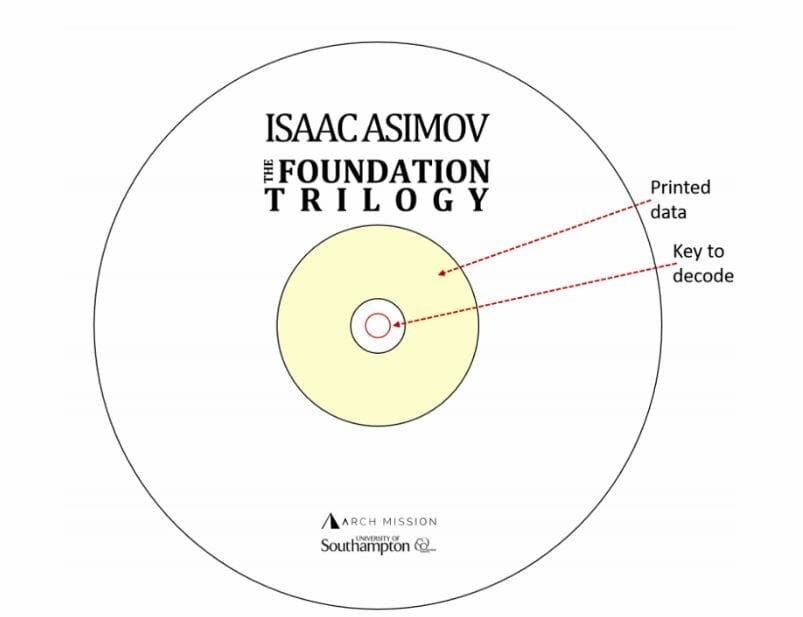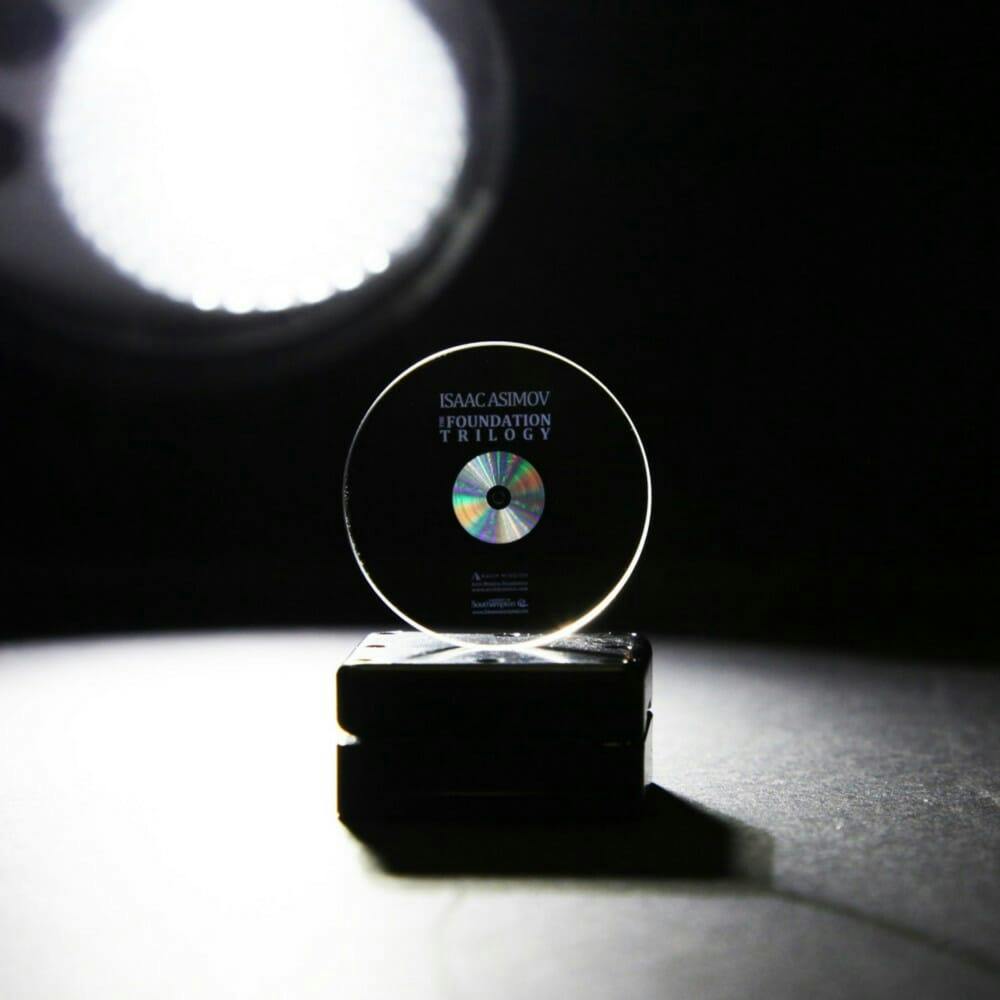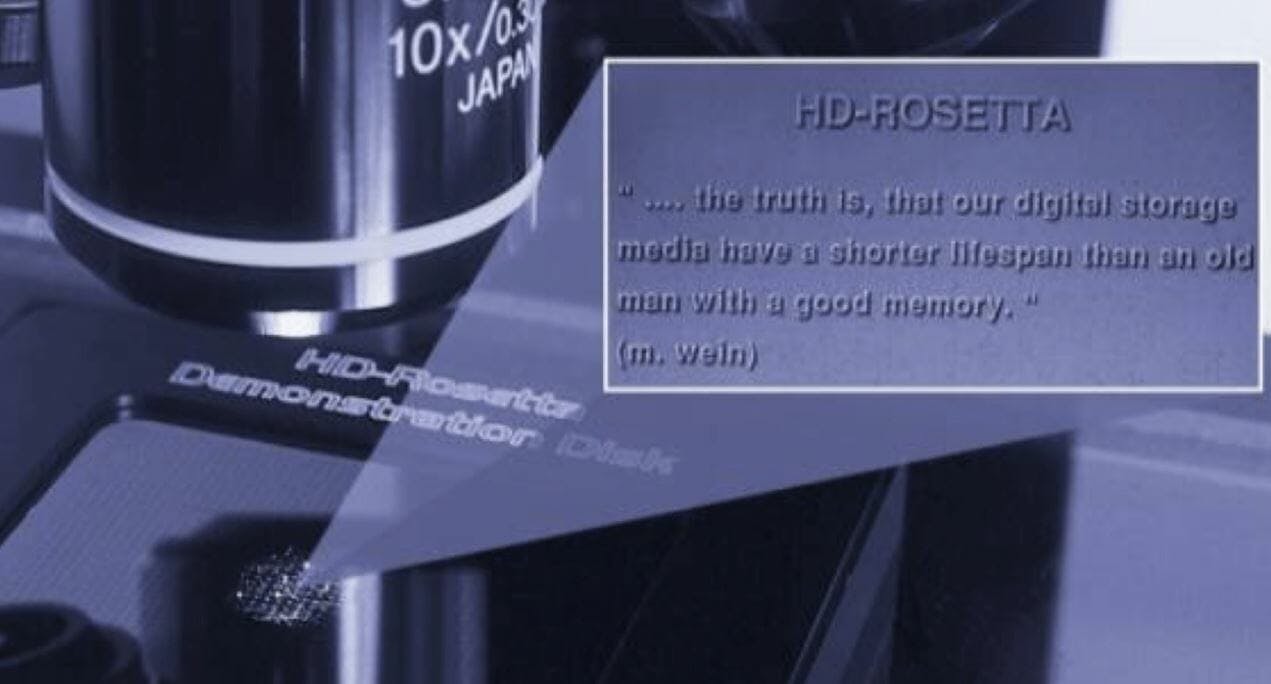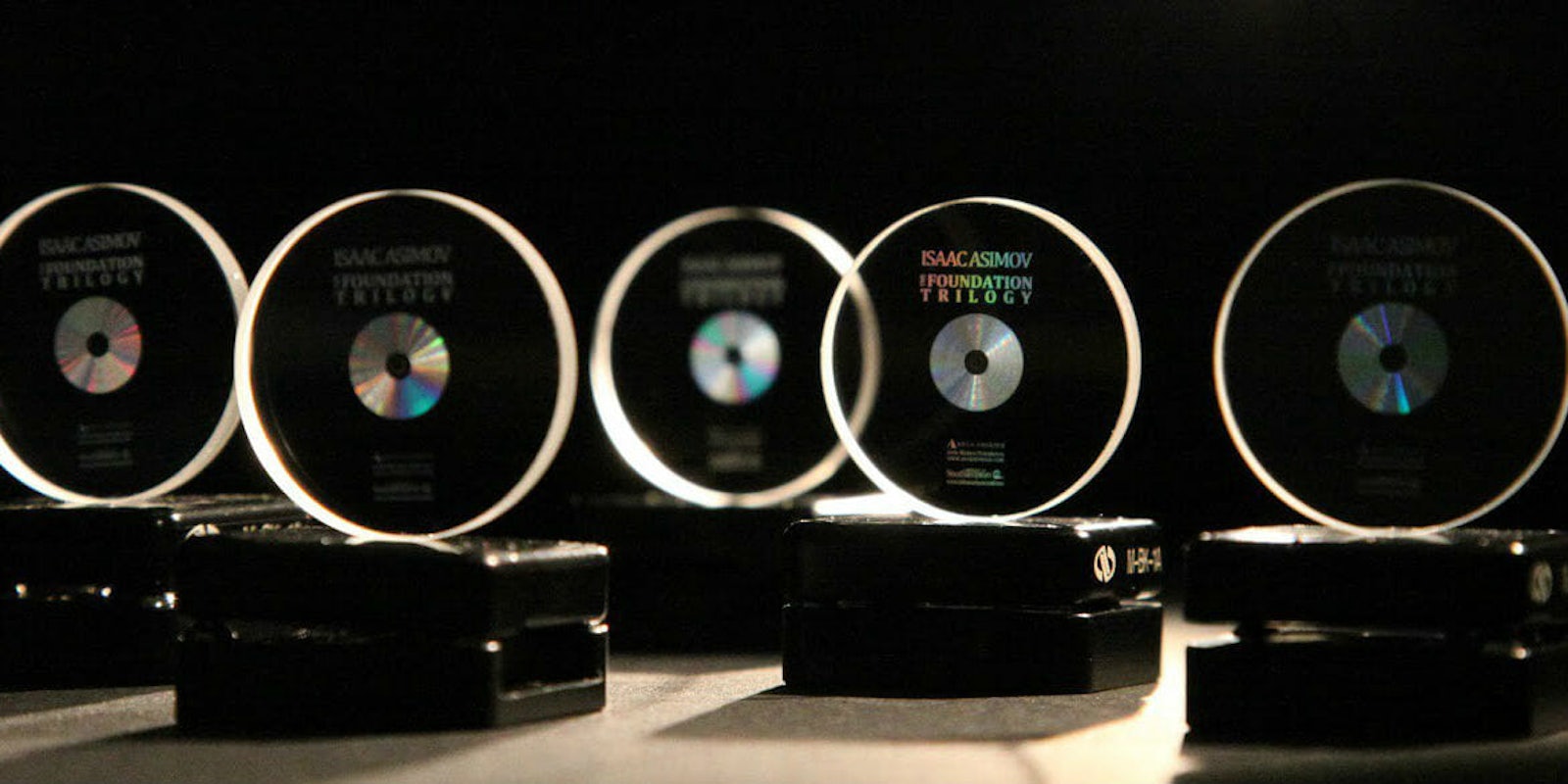When SpaceX successfully launched its Falcon Heavy rocket and shot its payload into deep space last week, it turned science-fiction into reality. Now, Elon Musk’s cherry red Tesla Roadster is on a billion-year journey around the sun, captained by Starman, a spacesuit-wearing mannequin.

But there was one component of the historic flight that many people overlooked. Sitting in the car was another mysterious passenger only mentioned in passing before the launch—a tiny, one-inch storage disk called an Arch (pronounced “Ark”). Its purpose is as ambitious as the flight that took it into space: to preserve humankind should it ever disappear.
What is Arch?
The Arch library floating toward Mars’ orbit is one in a series of five made from quartz silica (otherwise known as fused quartz) using new femtosecond laser techniques to create “5D optical storage.” Scientists call it the Superman memory crystal. Without overwhelming you with technical details (see here), these small crystals are capable of securely storing vast amounts of data and are expected to survive for 14 billion years. It’s believed that, within the next 10 years, a 3.75-inch version will be able to hold 360 terabytes of data, or about 7,000 Blu-ray disks. But like the Mars-bound Tesla, the Arch sent to space was just a test.

It only contained the three sci-fi novels in Isaac Asimov Foundation trilogy.”If there is anything else on the disk, for example, the private key to Satoshi Nakamoto’s lost Bitcoin wallet, we certainly wouldn’t admit that in public,” Nova Spivack, co-founder of the Arch Mission Foundation, joked. (Disclosure: Spivack is on the Daily Dot’s board of directors and an investor in the company.) The books are the inspiration for the foundation, the nonprofit organization behind the Arch libraries. For those who aren’t familiar, Asimov, in the Foundation novels, envisions a way to preserve humanity. The novel’s protagonist, Hari Seldon, predicts the demise of his empire and suggests creating an “Encyclopedia Galactica,” a collection of everything known in a civilization.
The Arch Mission Foundation, made up of scientists, researchers, and entrepreneurs, wants to create its own comprehensive history of humankind. The disk sent to space, filled with just three megabytes of memory, is a small sample of what’s to come.
The goal to send a disk into space was kept secret apart from a reply buried in dozens of responses to Musk’s space-bound Tesla unveiling. Spivack and his team knew Musk was a fan of the Foundation trilogy and decided, on the off chance they meet, they could give it to him as a gift. When Musk posted the tweet that revealed the Falcon Heavy’s payload, it felt like “serendipity,” Spivack said.
(Friends pls RT this so @elonmusk notices it thx!) Dear Elon, we made you a data crystal that lasts 14B years, containing Asimov’s Foundation Trilogy. Weight < 5 grams — Can we send it along on the ride to Mars? See: https://t.co/2OYnEdYNwc – contact me and you can have it!
— Nova Spivack (@novaspivack) December 2, 2017
Musk welcomed the project, but there was one condition: The first Arch would go in his personal library. Spivack was happy to oblige.
The public didn’t learn about the Arch until launch day. Spivack explains the decision to keep quiet was both due to the uncertainty of the launch and out of respect for SpaceX. “This was a SpaceX event. Nobody wanted to distract from that story,” Spivack said.
And yet, something unexpected happened minutes before launch. On its livestream, SpaceX name-dropped Arch and gave a brief summary of its goals.”We had no idea that they were going to do that live segment about us,” Spivack said. “And when they did, we were just screaming, we were jumping, we were high-fiving. It was an incredible moment of just amazement and joy and we were just really excited. I honestly started weeping it was so cool, just joy.”
The first five Archs are made using the same lengthy, expensive process that requires a lab full of scientists and engineers with millions of dollars worth of equipment. In their current form, these durable crystals are not scalable to the extent required of the foundation’s lofty goals. That’s why a variety of formats will be used to store data. “It’s not about the tech; it’s about the purpose,” Spivack said.
That purpose is to use durable storage devices to keep a record of humankind for billions of years, which can only be done by shooting massive amounts of Archs into space.

“What makes us really different from what has come before is that this is about massive replication, massive redundancy,” Spivack said. “It’s putting the data in lots of places and copying many times and continually updating it. So that, even if one location gets destroyed by a comet, or meteor impact or something, the other locations are still there.”
Other forms the foundation is looking into include non-living DNA storage, storage on nickel flash drives made for space, and long-format DVD storage. These will help it reach its eventual goal of putting copies of human history in the solar system, including on Mars, the Moon, and other planets. In doing so, it will preserve our civilization in case of a natural disaster, like solar flares or asteroids, or an increasingly possible thermonuclear war.
There are several other use cases for space-ready backup drives. If we ever truly become an interplanetary species, having a copy of everything we know, without having to contact Earth, would be invaluable. The Arch Mission Foundation also believes its Arch libraries could one day be used as the groundwork for an internet on Mars. Then, of course, there’s the sci-fi dream of an alien species coming across one of these devices.
But how do you choose the most important pieces of information to preserve, especially when given current storage limitations? Spivack said the foundation is leaving that to the experts. “We are meta curators; we curate the curators,” he quipped. “In sending huge curated data sets owned by others, we let others who are really good curators make the decisions. So the Wikipedia is curating the Wikipedia, not us. We’ll just give it a ride, just encode it and send it.”
As time goes on, storage technology will advance, making decisions about what gets sent up easier. If in the next 10 years, a device is made that can store all of human history, it will become less about what to send and more about how to get access to it and write it to a drive as quickly as possible. Spivack says the foundation will one day let anybody who donates own their own Arch, where they can store photos, videos, messages, and other personal memories.
Until then, the foundation will need to make decisions about what storage to bring based on how much can be sent up during a mission. Spivack said “broadly appealing and participatory” information from a range of subjects—science, math, history, languages, folklore, traditions, literature, philosophy, religion, art, music, film, and others—will go first. “In the long run, we’ll represent all perspectives, all knowledge, even the bad stuff because that’s part of our human legacy,” Spivach said. “However, we aren’t about marketing anybody’s view, so there’s view for everybody in the arch, just like there is on the internet. It’s not about a battle of belief systems.”
Much of the decision boils down to the availability of data—and potential funding. For now, it’s using open-source and public domain datasets from well-known aggregators like Wikipedia, Project Gutenberg, Wolfram Alpha, and the Internet Archive. If the Arch Mission Foundation can get its hands on it, it will send it into space.
“This is really a catalyst for a lot of thinking and innovation and social and technological progress, and ultimately a unifying grand cultural project that I think every nation on Earth can agree to,” Spivack said. “It’s important to all of us, it doesn’t matter what you believe. We’re not deciding whose information is better. However, we will give preference when funding is a critical part of it.”

The bold future of Arch
The Arch currently floating somewhere in space on an endless round-trip journey around the sun looks to have a safe path ahead of it. It will not impact any planetary body for millions of years. The closest it will get to Mars is 4.3 million miles away.
The Arch Mission Foundation is designing a special Arch library destined for the Moon by 2020. It will include “the most important documents, photos, videos, and data of our species and will last for as long as the Moon itself.” Another Arch is being made for Mars with a copy of large portions of the internet.
Like cryonics, the Arch Mission Foundation’s ultimate goals rely on the technology of the distant future. One of the big challenges is discovering new scalable methods for storing vast amounts of data. The foundation believes its recent efforts will help inspire further research into mass storage systems.
Equally important is the ability for other humans and alien lifeforms to access the data. When asked how he expects other species to decode the information, Spivack said the organization is sending up primers and making some data—depending on materials—visible via a microscope. Digital messages will include simple instructions for what all the data means. If it can solve these technical roadblocks, the Archs may one day be the only remaining trace of our species. Or maybe they’ll just end up as space junk. There’s only so much the Arch Mission Foundation can control.
“Ultimately, there are certainly going to be cases that you could imagine where a recipient other than humans doesn’t have sense organs and eats silica, just thinks these things are snacks,” Spivack said. “But there is a very good probability that a recipient would make sense of some or all of it. Now, whether they can relate to it, whether they happen to find out pop music enjoyable or extremely painful is something we just can’t control.”
Correction: This story has been updated to correct the spelling of Project Gutenberg.


